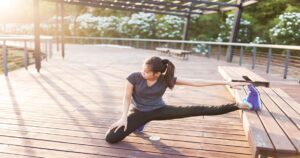Each individual has been advised to engage in stretching before to physical activity or participation in any sport, as the advantages of stretching are manifold. Physical activity undeniably offers a multitude of health advantages, and workouts have become an essential component of our daily routines. Nevertheless, sustaining injuries during physical exercise or engaging in sports is a prevalent occurrence. Therefore, prioritizing injury avoidance and acquiring flexibility should be of utmost importance.

Stretching muscles is an essential component of physical health and is commonly recognized as the most efficient approach to preventing injuries. Muscular strength, flexibility, and overall health are sustained.
Another substantiating element for the importance of stretching is the imperative for the human body to sustain a range of motion in its joints, hence enhancing mobility and flexibility over time.
Ever pondered the reasons behind the pain and pleasure associated with stretching? The pleasure associated with stretching is mostly attributed to a combination of scientific and physiological causes. The benefits of stretching, or rather, the delight of stretching, are enhanced by the production of endorphins, activation of the rest and digesting system, improved blood flow, and decreased muscular stiffness. Now, let us proceed to the crucial elements of stretching for the purpose of preventing injuries!
What is the significance of muscle stretching in preventing injuries?
According to scholarly study, there exist numerous advantages associated with the practice of dynamic stretching. Prior to participating in physical exercise, it has been demonstrated that integrating dynamic stretching activities can improve performance and alleviate musculoskeletal imbalances. The practice of muscle stretching has been observed to yield advantageous outcomes in injury prevention owing to its capacity to:
-
Enhance Adaptability
Flexibility is an essential element in injury prevention and is particularly advantageous for persons who spend extended periods of time sitting, typically 8-9 hours, in their occupation. The act of stretching has a vital role in improving the flexibility of joints and muscles, facilitating seamless movements such as bending, twisting, and reaching.
Before initiating a physical activity, it is recommended to partake in activities that promote flexibility and stretching. Furthermore, in modern work settings or physically demanding professions, prioritizing the cultivation of flexibility could empower individuals to extend their joints without suffering from ailments. This can also assist individuals in rectifying postural issues that may result in harm.
-
Reduces the likelihood of strains and sprains.
Ligament sprains and muscle strains may occur during physical activity or even when seated. Engaging in muscular stretching enhances and expands the flexibility of the ankle joint. The enhanced blood supply facilitates improved muscular performance. An ankle that possesses strength and flexibility is less susceptible to injury due to the ability of loose joints to respond rapidly.

In addition to its role in injury prevention, stretching has various other advantages. Let us briefly address the topic.
Advantages of Stretching
-
Enhances Hemodynamic Circulation
The act of stretching has been shown to enhance blood circulation, elevate oxygen levels within the human body, and facilitate the transportation of nutrients to the muscles. Additionally, it facilitates the elimination of metabolic waste products, including carbon dioxide, uric acid, and ammonia. Prior to engaging in treadmill workouts or running, it is imperative to engage in stretching exercises targeting the hamstrings, calves, and quadriceps.
-
Enhances adaptability
As previously stated, the act of stretching contributes to the enhancement of flexibility, hence facilitating the expansion of joint range of motion. The ability to bend more easily is greatly beneficial for an individual. It is important to avoid excessive stretching. Excessive stretching can cause harm to the muscles and prolong the process of achieving flexibility.
-
Enhanced Athletic Performance
Muscle stretching enhances flexibility, making it beneficial for sports. Engaging in physical activity has been shown to enhance performance and posture, optimize movement efficiency, prevent improper body alignment, sustain appropriate muscle length, and mitigate the likelihood of injuries. For example, swimmers can enhance their shoulder range of motion by engaging in stretching exercises, leading to enhanced performance. One of the most esteemed stretching exercises is widely recognized.
-
Facilitates the attainment of an enhanced posture.
Muscle stretching is a deliberate exercise that engages our muscles, enhancing their strength and optimizing their performance, ultimately leading to improved posture. To attain an enhanced posture, it is crucial to fortify and elongate the muscles in the upper back, chest, and core.
-
Alleviation of Stress and Psychological Advantages
Stretching is believed to have a significant impact on an individual’s mental health and overall well-being. Research indicates that stretching has several advantages, such as elevating serotonin levels, a hormone that aids in mood stabilization, reducing stress, and promoting positive emotions. Therefore, it has the potential to effectively alleviate depression and anxiety.
Engaging in frequent stretching, even for a brief duration, is beneficial for the human body. Individuals can engage in daily flexibility and stretching exercises. Let us record those!
The most effective stretching exercises for achieving full body relaxation
The neck roll is a therapeutic technique that aids in the alleviation of neck tension, pain reduction, and enhanced flexibility. This approach is ideal for individuals who spend 8-9 hours sitting upright at their workplace, as it effectively stretches their muscles.
The shoulder roll is a highly efficient stretching exercise that aids in the maintenance of proper body posture. This particular stretching technique facilitates the relaxation of the taut muscles located in the neck and upper back, hence promoting muscle flexibility.
The Standing Side Stretch is a stretching technique that enhances the strength of the shoulders and core as well. The enhancement of shoulder and side mobility in the human body is widely recognized. Regularly engaging in this activity can effectively alleviate bodily tension.
The Forward Bend is a Yoga technique that involves bringing the upper body in close proximity to the lower body, hence stimulating the stomach, quadriceps, and calf muscles. Moreover, this particular technique effectively elongates the hamstrings, hip muscles, and lumbar region.
The Seated Torso Stretch is a regular stretching method that can be practiced. The exercise regimen primarily focuses on the musculature of the back and core, thereby enhancing the flexibility of the hips and alleviating tension in the shoulders and back.
Guidelines for Promoting Safe Muscle Stretching
In addition to numerous advantages associated with stretching, it is worth noting that in certain instances, it may result in physical unease, particularly when an individual possesses any preexisting medical disorders. In order to ensure safety during muscle stretching, it is advisable for everyone to adhere to appropriate safety protocols. These can include:
- Warming up before to stretching
- Commencing the action gradually and delicately
- Adhering to proper posture, ceasing when experiencing pain, and exhaling gradually while engaging in stretching exercises.
- Focusing on the muscle undergoing stretching
It is vital to comprehend that the consistent practice of flexibility and stretching workouts is crucial. Furthermore, individuals with chronic conditions or injuries may require modifications to their stretching routines. We trust that this information will be beneficial to you. Have a pleasant stretching session!
